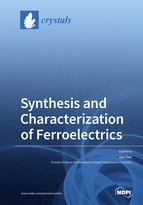Synthesis and Characterization of Ferroelectrics
A special issue of Crystals (ISSN 2073-4352). This special issue belongs to the section "Inorganic Crystalline Materials".
Deadline for manuscript submissions: closed (31 March 2020) | Viewed by 19727
Special Issue Editor
Interests: relaxor ferroelectrics; domain structure of ferroelectrics; low-frequency dielectric relaxation; non-linear dielectric response; mesoscopic disorder in ferroics
Special Issues, Collections and Topics in MDPI journals
Special Issue Information
Dear colleagues,
Ferroelectrics have been one of the most used and studied materials in both scientific and industrial communities. In addition to their foremost property (ferroelectricity), these materials also display other numerous attractive utility properties, such as piezoelectricity, piroelectricity, and electro-optics, which designate them as multifunctional materials particularly suitable for a wide range of applications ranging from effective sensors, actuators, and transducers to optical and memory devices. Since the discovery of ferroelectricity in Rochelle Salt in 1920 by J. Valasek, numerous applications using such effects have been developed. In addition, ferroelectrics and other ferroics exhibit a highly non-linear response, which is changeable rather then fixed, and thus are able to mimic to a large extent biological systems. This is why this kind of behavior is qualified as “smartness” and their respective systems are termed as “smart materials”.
All of the above features are strongly related to the material structure. This particularly applies to relaxor ferroelectrics, which are known as intrinsically inhomogeneous at various length scales with the frustration of local polarization. This characteristic limits the achievement of long-range ferroelectric order at a global scale. This accounts for the variety of mesoscale structures and the tendency for the specific pattern formation responsible for the particular properties of relaxors.
Recently high-performance lead-free piezoelectric ceramics have attracted much attention from the research community. This is due to the European Union’s (EU) legislation on hazardous substances in electronic components. At present, the vast majority of piezoelectric devices are based on solid solutions of lead-containing oxides. Thus, effective lead-free alternatives constitute a subject of increasing interest both in basic and applied research investigations.
The purpose of this collection is to present an up-to-date view of ferroelectric multifunctional and smart materials, which are considered to be among the future's most important materials. This Special Issue of Crystals aims to explore all aspects of crystal structure, crystal growth, ceramic technology, and characterization techniques of ferroelectric materials. Your contributions to the above issue are warmly welcome
Prof. Jan Dec
Guest Editor
Manuscript Submission Information
Manuscripts should be submitted online at www.mdpi.com by registering and logging in to this website. Once you are registered, click here to go to the submission form. Manuscripts can be submitted until the deadline. All submissions that pass pre-check are peer-reviewed. Accepted papers will be published continuously in the journal (as soon as accepted) and will be listed together on the special issue website. Research articles, review articles as well as short communications are invited. For planned papers, a title and short abstract (about 100 words) can be sent to the Editorial Office for announcement on this website.
Submitted manuscripts should not have been published previously, nor be under consideration for publication elsewhere (except conference proceedings papers). All manuscripts are thoroughly refereed through a single-blind peer-review process. A guide for authors and other relevant information for submission of manuscripts is available on the Instructions for Authors page. Crystals is an international peer-reviewed open access monthly journal published by MDPI.
Please visit the Instructions for Authors page before submitting a manuscript. The Article Processing Charge (APC) for publication in this open access journal is 2600 CHF (Swiss Francs). Submitted papers should be well formatted and use good English. Authors may use MDPI's English editing service prior to publication or during author revisions.
Keywords
- ferroelectrics
- relaxor ferroelectrics
- multifunctional materials
- smart materials
- single crystals
- ceramics
- domains
- dielectric relaxation
- lattice dynamics
- ferroic glasses






